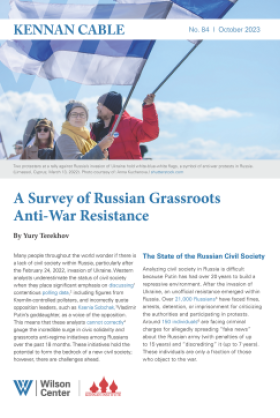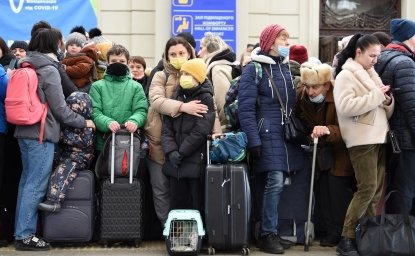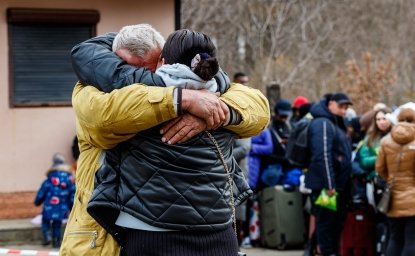Kennan Cable No. 84: A Survey of Russian Grassroots Anti-War Resistance


Many people throughout the world wonder if there is a lack of civil society within Russia, particularly after the February 24, 2022, invasion of Ukraine. Western analysts underestimate the status of civil society when they place significant emphasis on discussing[1] contentious polling data,[2] including figures from Kremlin-controlled pollsters, and incorrectly quote opposition leaders, such as Ksenia Sobchak,[3] Vladimir Putin's goddaughter, as a voice of the opposition. This means that these analysts cannot correctly[4] gauge the incredible surge in civic solidarity and grassroots anti-regime initiatives among Russians over the past 18 months. These initiatives hold the potential to form the bedrock of a new civil society; however, there are challenges ahead.
The State of the Russian Civil Society
Analyzing civil society in Russia is difficult because Putin has had over 20 years to build a repressive environment. After the invasion of Ukraine, an unofficial resistance emerged within Russia. Over 21,000 Russians[5] have faced fines, arrests, detention, or imprisonment for criticizing the authorities and participating in protests. Around 150 individuals[6] are facing criminal charges for allegedly spreading "fake news" about the Russian army (with penalties of up to 15 years) and "discrediting" it (up to 7 years). These individuals are only a fraction of those who object to the war.
The Russian anti-war movement is fractured.[7] Russian society lacks institutions capable of organizing protests effectively. For most Russian people, taking to the streets is viewed as a moral obligation and symbolic gesture rather than a functional tool of resistance against the authorities. Two examples of this kind of protest include that undertaken by poet Artem Kamardin,[8] who was recently detained for reading anti-war poetry in a Moscow square, and by Sasha Skochilenko,[9]a young artist who faces years in prison for changing price tags to anti-war messages in supermarkets across St. Petersburg.
Successful, unified resistance thrives only when built upon tight horizontal social bonds, a scenario that does not align with Putin’s system, where the state actively dismantles such connections. But over the last 18 months, hundreds of interconnected grassroots anti-war or resistance initiatives have sprouted, uniting Russians within and beyond the nation's borders. There is hope for the fractured nature of Russian civil society. The ecosystem of emerging horizontal resistance groups among Russians can serve as the institutional and moral foundation of a new civil society, as well as catalysts for the transformation of the nation.
Categorizing the Initiatives
Through my research and personal connections, I have gathered data on 302 protest organizations. Most of this data emerged shortly before or soon after February 24, 2022. I wanted to identify the structure, motivation of participants, areas of activity, accomplishments, and challenges these organizations face, based on surveys and interviews. I have classified these projects into nine categories based on their areas of activity:
- Protest diaspora organizations include 108 groups based in 44 countries.
- Activist-to-activist (A2A) projects include 65 initiatives to aid people in relocation, help them avoid mobilization, and provide both legal and psychological support.
- Support initiatives for Ukrainians by Russians focus on aiding Ukrainian refugees, displaced persons, and the Ukrainian army. There are 26 projects in this category.
- New independent media outlets encompass 30 small and medium-sized companies that operate across various digital platforms.
- Peaceful resistance political organizations encompass 37 youth, feminist, and street-level "guerrilla" political groups.
- Active, violent, and armed resistance organizations include 10 groups.
- Anti-war art projects include 13 projects.
- Decolonization projects of national minorities include 10 projects.
- New think tanks include three organizations.
Many anti-war initiatives remain undisclosed due to safety concerns for their participants, and the activities of many organizations overlap with one another. Thirty-eight of the initiatives wholly operate within Russia. The other initiatives are mainly headquartered outside the country, for safety reasons.
The most active, visible, and numerous organizations are those within the Russian protest diaspora. Their range of activities is also diverse, encompassing protests (including regular global actions), community-building events, aid collection for Ukrainian refugees and the army, pen-pal evenings for Russian political prisoners, assistance for newly arrived Russian emigrants, educational events, cultural activities like exhibitions and concerts, investigation of Russian malicious state influence in host countries, and advocacy for Russian refugees.
Many grassroots resistance initiatives operate in unfavorable conditions. In Russia, those involved face imprisonment. When abroad, national authorities, especially in Europe, regard associations of Russians with considerable caution. As a result, 80 percent of the grassroots resistance initiatives based abroad do not possess official Non-Governmental Organization (NGO) status, although they strive to attain this recognition.
Most communities are formed within chat groups on platforms such as Telegram or Facebook. They find supporters through social media and public events. The active membership of such communities varies from several dozen to 5,000, though some volunteer chat groups may consist of tens of thousands. These communities are managed by an elected board, averaging about 10 individuals. Almost all community managers emphasize the horizontal nature of their groups. A deep-seated mistrust of "leaderism" and centralization in management holds a significant place in the psychology of anti-war activists.
Grassroots Achievements and Experience
The grassroots anti-war initiatives among Russians have had multiple achievements and experiences while navigating the current war. The shock and disorientation experienced[10] by the most active segment of Russian society shortly after the onset of the full-scale war transformed into a desire to take action. This required overcoming fragmentation and societal atomization and establishing horizontal connections among activists. The citizens of a country where historical reforms and social changes have historically been initiated top-down quickly created hundreds of new grassroots organizations.
Russians have the ability to create sustainable civil society structures. Activists consider themselves fragments of the Russian opposition and explicitly see themselves as a civic replacement for Russian official institutions abroad, akin to the infamous Rossotrudnichestvo, a state agency formally promoting Russian culture, language, and business abroad but suspected[11] spreading propaganda and undertaking malicious activities. These new communities perceive themselves as a bridge between emigrants, the free world, and Russians in Russia, creating a sort of common space infrastructure.
Through art, think tanks, and decolonization projects, the national idea, Russian identity, and imperialism are being rethought. These topics were nearly absent from Russian opposition discourse in the past. Many Russians are familiar with prominent independent media outlets like Meduza, Novaya Gazeta, and Dozhd TV, but their audience share is stable, as they seldom attempt to engage a wider social stratum. New activists face no such limitations. Armed struggle and violent regime change are no longer taboo subjects when there are Russians ready to take up arms against their own government without fearing accusations of being disloyal towards Russia.
The most active anti-Putin communities are in Prague, where they organized a 5,000-person march[12] and set up a school for children[13] of Ukrainian refugees in March 2022. In the U.S., Miami and Washington, DC regularly collect equipment for the Ukrainian army and launched the Freedom Birds for Ukraine[14] project to raise funds for drones. Minneapolis[15] hosts Russian refugees and organizes contact with state senators to advocate for political prisoners and Russian draft dodgers.
Among organizations aiding Ukrainians, the Warmth for Ukraine[16] initiative is notable for collecting $460,000 over the past winter to provide heaters, generators, and other equipment to Ukrainian hospitals and individuals left without heating due to continuous Russian attacks on civilian infrastructure. The volunteer organization Russians for Ukraine[17] has been welcoming and assisting Ukrainian refugees at the Polish-Ukrainian border in Przemyśl since the beginning of the full-scale war. Lastly, there is a vast network of volunteers within Russia itself, who host and arrange for the evacuation of Ukrainians, including children,[18] forcibly displaced from Russia-occupied territories, to Europe. Within Russia, artists and musicians have joined efforts to raise funds for Ukrainian refugees. During their concerts, Russian singers Oxxxymiron,[19] Noize MC,[20] Pornofilmy,[21] FACE,[22] and Monetochka[23] collected over $862,000. Russian authorities labeled them "foreign agents." Admission fees for free art events organized by Russian communities become donations for supporting Ukrainians.
The most striking example of nonviolent resistance within Russia is the Feminist Anti-War Resistance.[24] In 2022, it began targeting older women—a social category traditionally considered conservative and loyal to Putin. The group created, printed, and distributed the newspaper Women's Truth[25] to residential apartments. It crafted a series of viral anti-war postcards[26] sent in a style that particularly appealed to the older generation. These messages were disguised as the type of congratulatory message that Russian babushkas habitually send to their contacts on WhatsApp or Viber.
NITKA[27] is the largest Russian anti-regime channel focused on presenting politics, war, and repression through memes. Some of these videos garner millions of views, outpacing Russian opposition politicians and major media outlets by far.
Partisan groups operate in Russia, even with the threat of Putin’s regime. These groups are linked to setting military recruitment offices on fire, regularly damaging railway infrastructure, conducting sabotage at warehouses, and likely launching drones. The Warsaw-based organization Civic Council[28] recruited at least several dozen Russians into the Ukrainian Armed Forces, and I personally know such individuals. The existence of the Russian Volunteer Corps,[29] the Freedom of Russia Legion,[30] and the Siberian Battalion,[31] comprised of Russian citizens fighting on the Ukrainian side, is no longer undisputed after their raids in the Bryansk and Belgorod regions of Russia.
There is an entire ecosystem of grassroots civil organizations. There have been several attempts to formalize this ecosystem through activist coalitions like:
- The Berlin Platform of Anti-War Initiatives,[32] which includes over 60 projects, formed after the Berlin Congress in December 2022.
- Russian America for Democracy in Russia (RADR),[33] a nonprofit uniting 18 communities across different parts of the U.S.
- Free Russians Global,[34] an informal coalition of activists for coordination and information-sharing, formed in July 2022 after the Anti-War Communities Convention in Prague.
- Voice of Free Russia,[35] a horizontal movement of activists and diasporas in Europe advocating for nonviolent resistance.
Challenges
There are four challenges[36] for these grassroots organizations. First, on the intra-organizational level, most of these projects emerged spontaneously, explosively, as reactions to the war, and were typically entirely volunteer-driven. This became a full-fledged second job for activists. This job is unpaid and quite psychologically challenging, especially when involving work with Ukrainian refugees. Burnout has emerged among the activists.
Second, even though activists want to continue fighting, access to grants and funding is challenging because they frequently lack the means, skills, and time for fundraising and completing grant applications, even if these are publicly available. Also, many organizations are unable to become institutionalized and there can be bias among funders accustomed to working with large, established organizations and media outlets. European banks can deny applicants with Russian citizenship the ability to open accounts and this causes bureaucratic hurdles in registering NGOs also.
Third, as organizations are unable to obtain proper funding, they also face low media visibility. New grassroots movements require support from major opposition media outlets and well-known political influencers to make their presence known, but these outlets often view new grassroots movements as competitors.
Fourth, this demonstrates the last issue: understanding and trust between activists and professional opposition politicians. For example, in September 2022, a scandal erupted at the Congress of Free Russia[37] when most established professional politicians and political commentators left the hall during the speeches of representatives from grassroots anti-war projects. Collaboration between activists and politicians becomes sporadic and dependent on personal relationships and loyalty.
The grassroots anti-war movement is growing. Protest organizations have made significant strides throughout the Ukraine War and have demonstrated the presence of civil society in Russia. This is a remarkable effort.
[1] Tatiana Stanovaya, “Putin’s Age of Chaos,” Foreign Affairs, August 8, 2023, https://www.foreignaffairs.com/russian-federation/vladimir-putin-age-chaos.
[2] Ivan Kurilla, “Do Russians Support the War? How the Answer Reflects Biases, Uncertainty, and Old Divisions,” PONARS Eurasia, https://www.ponarseurasia.org/do-russians-support-the-war-how-the-answer-reflects-biases-uncertainty-and-old-divisions/.
[3] Anton Troianovski, “She Once Ran Against Putin. Her Advice Now: Resistance Is Futile,” New York Times, August 11, 2023, https://www.nytimes.com/2023/08/11/world/europe/ksenia-sobchak-putin-russia-ukraine-war.html.
[4] Christopher Isajiw, “Anti-War Russians Struggle to Be Heard,” Atlantic Council (blog), April 6, 2023, https://www.atlanticcouncil.org/blogs/ukrainealert/anti-war-russians-struggle-to-be-heard/.
[5] “Russia: More than 21,000 People Targeted in Sustained Crackdown on Anti-War Dissent—New Briefing,” press release, Amnesty International UK, https://www.amnesty.org.uk/press-releases/russia-more-21000-people-targeted-sustained-crackdown-anti-war-dissent-new-briefing.
[6] “Russia: More than 21,000 People Targeted.”
[7] Anna Kuleshova, “Why are Russians who oppose the war not taking to the streets?” Open Democracy, June 14, 2023, https://www.opendemocracy.net/en/odr/ukraine-war-why-russians-are-not-protesting/.
[8] Aleks Lokhmutov, “Russian Police Are Torturing Anti-War Activists,” Human Rights Watch (blog), October 20, 2022, https://www.hrw.org/news/2022/10/20/russian-police-are-torturing-anti-war-activists.
[9] “Trial of Russian Artist for Anti-War Supermarket Protest Begins,” Moscow Times, December 15, 2022, https://www.themoscowtimes.com/2022/12/15/trial-of-russian-artist-for-anti-war-supermarket-protest-begins-a79711.
[10] Robert Coalson, “Waking Up to War: Russian Anti-War Dissidents Recall the ‘Shock and Horror’ of the Invasion of Ukraine,” Radio Free Europe/Radio Liberty, https://www.rferl.org/a/russia-invasion-ukraine-anti-war-dissidents/32283219.html.
[11] Polina Nikolskaya, Mari Saito, Maria Tsvetkova, and Anton Zverev, “Pro-Putin Operatives in Germany Work to Turn Berlin against Ukraine,” Reuters, January 3, 2023, https://www.reuters.com/investigates/special-report/ukraine-crisis-germany-influencers/.
[12] “Russians Living in Prague Stage Anti-War Rally,” Deutsche Welle (DW), March 26, 2022, https://www.dw.com/en/ukraine-russians-living-in-prague-stage-anti-war-rally/a-61269816.
[13] “Пражская «Школа культурноi молодi»—чтобы не потерять поколение,” May 20, 2022, https://ruski.radio.cz/prazhskaya-shkola-kulturnoi-molodi-chtoby-ne-poteryat-pokolenie-8751000.
[14] Freedom Birds for Ukraine, fundraising campaign to help Ukraine, https://www.freedombirds.help.
[15] Russians Against War Minnesota (@raw_minnesota), Instagram, https://www.instagram.com/raw_minnesota/.
[16] “Let’s Help Ukraine Stay Warm Through the Winter,” https://wfu.world/en/.
[17] Russians for Ukraine, https://rfu2022.org/en/.
[18] Mary Ilyushina and Ksenia Ivanova, “Discreetly, and at Peril, Russian Volunteers Help Ukrainian Refugees,” Washington Post, February 25, 2023.
[19] “Oxxxymiron Собрал Почти $200 Тысяч На Помощь Украинским Беженцам: «Украине—Мир, России—Свобода,» RAP.RU, https://www.rap.ru/news/15347.
[20] Victoria Zhuravleva, “Монеточка и Noize MC собрали 335 тысяч евро на благотворительных концертах,” https://momenty.org/people/15383.
[21] “«С 24 февраля нам стало совсем не до песен» Интервью Володи Котлярова—солиста группы «Порнофильмы». О списке запрещенных групп, отмене концертов и о том, пройдет ли все это,” https://meduza.io/feature/2022/07/31/s-24-fevralya-nam-stalo-sovsem-ne-do-pesen.
[22] “‘Мне больно и стыдно’: рэпер Face выступил в Варшаве в поддержку Украины,” March 29, 2022, https://www.bbc.com/russian/media-60920658.
[23] Zhuravleva, “Монеточка и Noize MC собрали.”
[24] Daria Dergacheva, “‘We Were Born in a Situation of Hellish Urgency’: How the Russian Feminist Anti-War Resistance Movement Works,” Global Voices (blog), November 16, 2022, https://globalvoices.org/2022/11/16/we-were-born-in-a-situation-of-hellish-urgency-how-the-russian-feminist-anti-war-resistance-movement-works/.
[25] Andrey Serafimov, “Женский Протест Может Стать Ядром Антивоенного Движения,” openDemocracy, https://www.opendemocracy.net/ru/feministskoe-antivoennoe-soprotivlenie-serafimov/.
[26] Masha Ivansenko, “Strategies of Anti-War Movements in Russia,” Cultures of Remembrance, https://cultures-of-remembrance.com/en/essays/strategies-of-anti-war-movements-in-russia/.
[27] NITKA (@nitka_tt), TikTok, https://www.tiktok.com/@nitka_tt.
[28] Гражданский Совет, https://civiccouncil.info/.
[29] Ilyushina and Ivanova, “Discreetly, and at Peril, Russian Volunteers Help Ukrainian Refugees.”
[30]Легион “Свобода России,” “Главная,” https://legionliberty.army/.
[31] Telewizja Polska, “Former Russian Officer Forms Battalion to Support Ukraine: Report,” April 11, 2023, https://tvpworld.com/69097317/former-russian-officer-forms-battalion-to-support-ukraine-report.
[32] True Russia, “The Gathering of Civic Anti-war and Humanitarian Initiatives in Berlin,” https://truerussia.org/en/projects/sobranie-grazhdanskikh-antivoennykh-i-gumanitarnykh-initsiativ/.
33] Russian America for Democracy in Russia Inc., https://donatestock.com/russian-america-for-democracy-in-russia-inc.
[34] Free Russians Global,” https://freerussiansglobal.cz/.
[35] Voice of Free Russia, https://linktr.ee/voiceoffreerussia.
[36] Alexey Sidorenko, “Что Мешает Антивоенному Движению Объединиться?” Colta.Ru, https://www.colta.ru/articles/vokrug_gorizontali/29713-anti-war-movement.
[37] “Отцы и дети русской оппозиции. Как (не) выстраивается диалог между звёздными политэмигрантами и низовыми активистами,” https://discours.io/articles/social/celebrities-vs-activists.
Author

International Political Analyst and Media Manager

Kennan Institute
The Kennan Institute is the premier US center for advanced research on Eurasia and the oldest and largest regional program at the Woodrow Wilson International Center for Scholars. The Kennan Institute is committed to improving American understanding of Russia, Ukraine, Central Asia, the South Caucasus, and the surrounding region through research and exchange. Read more






